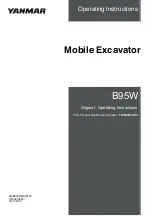
.
SAFETY
SAFETY INFORMATION
ATTACHMENT INSTALLATION
When installing optional parts or attachments, there may be problems with safety or legal restrictions. Therefore
contact your Komatsu distributor for advice.
Any injuries, accidents, or product failures resulting from the use of unauthorized attachments or parts will not be
the responsibility of Komatsu.
When installing and using optional attachments, read the instruction manual for the attachment, and the general
information related to attachments in this manual.
ATTACHMENT COMBINATIONS
Depending on the type or combination of work equipment, there is a hazard that the work equipment may hit the cab
or other parts of the machine. Before using unfamiliar work equipment, check if there is any hazard of interference,
and operate with caution.
CAB WINDOW GLASSES
If the cab glass on the work equipment side is broken, there is a hazard that the work equipment may contact the
operator's body directly. Stop operation immediately and replace the glass.
UNAUTHORIZED MODIFICATIONS
Any modification made without authorization from Komatsu can create hazards. Before making a modification,
consult your Komatsu distributor.
Komatsu will not be responsible for any injuries, accidents, product failures or other property damages resulting
from modifications made without authorization from Komatsu.
SAFETY AT JOBSITE
Before starting operations, thoroughly check the area for any unusual conditions that could be dangerous.
When carrying out operations near combustible materials such as thatched roofs, dry leaves or dry grass, there
is a hazard of fire, so be careful when operating.
Check the terrain and condition of the ground at the worksite, and determine the safest method of operation. Do
not carry out operations at places where there is a hazard of landslides or falling rocks.
If water lines, gas lines, or high-voltage electrical lines may be
buried under the worksite, contact each utility and identify their
locations. Be careful not to sever or damage any of these lines.
Take necessary measures to prevent any unauthorized person
from entering the operating area.
In particular, if you need to operate on a road, protect pedestrian
and cars by designating a person for worksite traffic duty or by
installing fences around the worksite.
When traveling or operating in shallow water or on soft ground,
check the shape and condition of the bedrock, and the depth
and speed of flow of the water before starting operations.
WORKING ON LOOSE GROUND
Avoid traveling or operating your machine too close to the edge of cliffs, overhangs, and deep ditches. The
ground may be weak in such areas. If the ground should collapse under the weight or vibration of the machine,
there is a hazard that the machine may fall or tip over. Remember that the soil after heavy rain or blasting or after
earthquakes is weak in these areas.
When working on embankments or near excavated ditches, there is a hazard that the weight and vibration of the
machine will cause the soil to collapse. Before starting operations, take steps to ensure that the ground is safe
and to prevent the machine from rolling over or falling.
2 - 16
Summary of Contents for Galeo PC27MR-2
Page 1: ......
Page 2: ... 1 1 ...
Page 4: ... FOREWORD FOREWORD 1 3 ...
Page 5: ... FOREWORD FOREWORD 1 4 ...
Page 15: ... 2 1 ...
Page 53: ... 3 1 ...
Page 166: ... 4 1 ...
Page 224: ... 5 1 ...
Page 227: ... 6 1 ...
Page 255: ... 7 1 ...





































